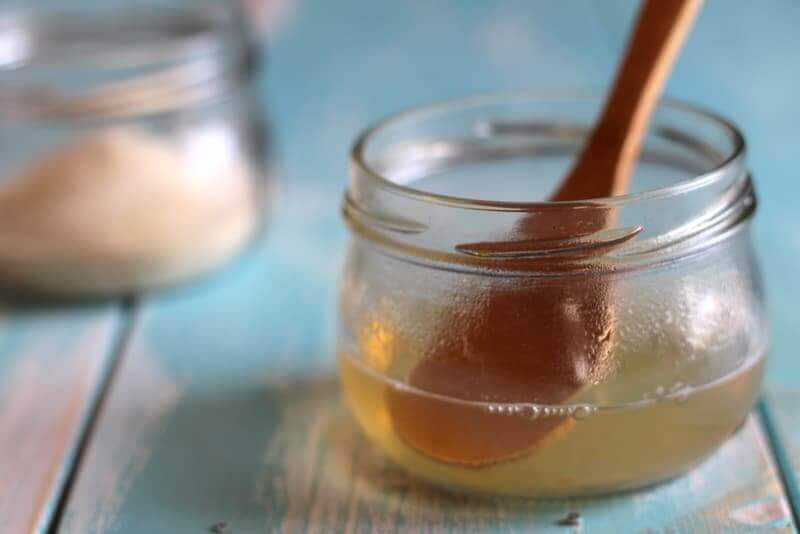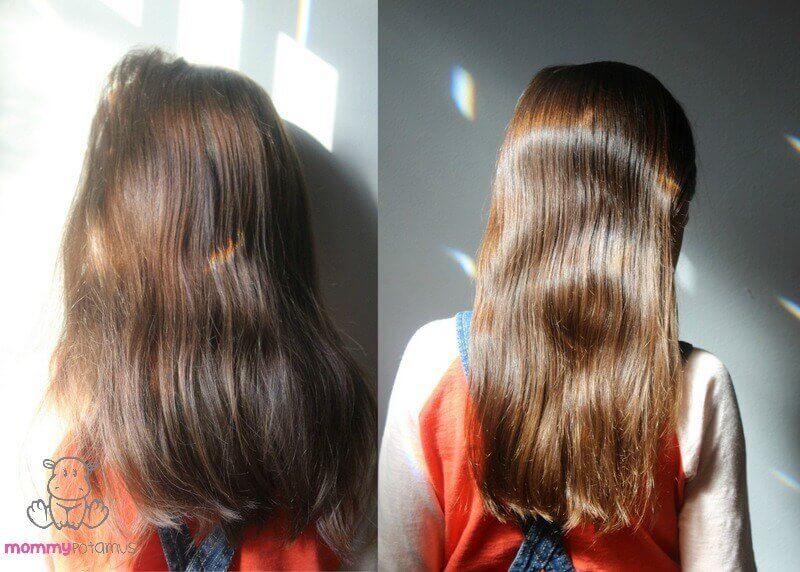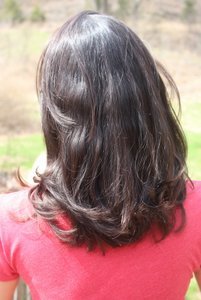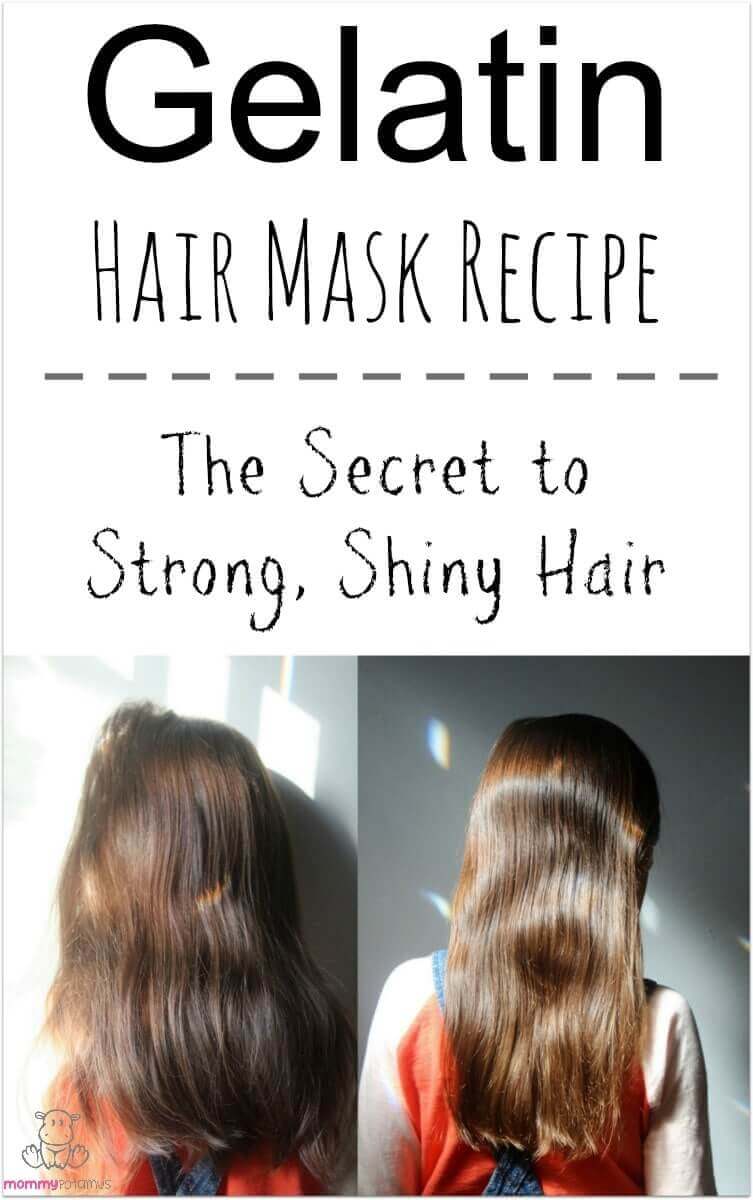
“So, what do you wash your hair with?”
“Mud.”
“I’m sorry?”
“Well, technically it’s clay.”
If you want to have an entertaining conversation with your stylist, try that as an opening line.
Then when they ask how you’ve managed to get your hair so smooth and shiny, tell them you put Jello on your hair. (Or rather, gelatin, the stuff that Jello is made of.)
Of course, if you haven’t tried these things, do that first!
Gelatin: The Secret To Shiny, Strong Hair
If your stylist has ever told you conditioners like Pantene might wreck your hair over time, here’s why:
Many store-bought conditioners contain silicone, which coats the hair to make it smooth and shiny. Unfortunately, this only makes the hair **look** healthy – in reality it’s doing the exact opposite. Silicone blocks moisture from reaching the hair shaft, which can cause strands to become dry and brittle over time.
A far better option is gelatin, which contains keratin proteins that actually bind with hair to strengthen it. Unlike whole proteins such as egg yolk, which have difficulty bonding with hair, the partially cooked proteins found in gelatin bond easily. Gelatin adheres especially well to damaged areas, but also nourishes the entire strand as well. It helps to smooth the hair cuticle, boost shine and reduce breakage.
Those with wavy or curly hair also report that it reduces frizz.
Something to keep in mind is that, when it comes to protein treatments for hair, you can get too much of a good thing. See the Tips & Troubleshooting section below for info on how to get the best results.
Because I’ve been using gelatin in my hair for awhile now, I couldn’t get a true “before” photo to share with you. Fortunately I had an adorable little volunteer that was willing to help me out. The photo below is of my daughter, Katie, before and after her first gelatin hair mask.


Her hair looks a little oily in the photo on the right, but it’s actually not at all. I’d just run a large-tooth comb though it, which made it separate in a funny way. Oops!
The photo on the right is my hair after the same treatment. My hair is a weird blend of straight and wavy when it air dries, but you can see that it’s not oily or greasy. It is super, super soft though – I love gelatin masks!
Back to my daughters before and after: The light is a little brighter in the second photo because the sun was higher, but the increase in shine is real. The photos were taken about two hours apart because I let her run around outside while her hair dried. Both are completely unretouched.
Gelatin Hair Mask Recipe
Ingredients
- 1 tablespoon powdered gelatin (where to buy grass-fed gelatin)
- 1/3 cup water (see optional add-ins for alternatives)
- 1 teaspoon apple cider vinegar (I use this brand)
- 1 teaspoon honey (I buy mine from a local beekeeper, but when he’s out of stock I order this brand)
Optional Add-Ins
Coconut Milk
Moisturizing. (Note: If you use homemade coconut milk, make sure to strain it through a coffee filter or you may end up with white flecks of coconut meat in your hair. Store-bought coconut milk will work fine – no filtering necessary.
Herbal Tea
Peppermint, rosemary and nettle tea – which add shine – are suitable for all hair types. Sage, marshmallow root and elderflower are helpful for dryhair.
Moisturizers
If your hair is very dry, you might try adding 1-2 tablespoons of avocado or banana to your mixture. Give it a whir in the blender before use to ensure even application.
Another option is to add a little bit of oil. A few drops may be enough, but some people add as much as one tablespoon. Oils to consider are olive, coconut, almond, and argan.
Essential Oils
Rosemary adds shine, chamomile is helpful for dry hair and tea tree is helpful for oily hair. For the recipe below, use 12-15 drops.

Making Your Gelatin Hair Mask
Add liquid to a small saucepan. Slowly sprinkle gelatin over your liquid while whisking to prevent lumps. Place the pan on your stove and allow the liquid to heat until steaming, stirring often with a spoon to prevent the gelatin from sticking to the bottom of the pan. When the mixture is steaming, remove it from heat.
When the mixture has cooled down somewhat – it should be warm but not so hot that it’s uncomfortable to touch – add in the honey, vinegar, and any optional ingredients.
Using Your Gelatin Hair Mask
When the mixture is warm but not so hot that it’s uncomfortable to touch, apply it to clean, wet hair. I like to dip the ends of my hair into the jar, then pour a little bit on one side of my scalp and work it down from roots to tips before moving to the other side.
Allow the mask to sit for 10-30 minutes. If you’re planning to let it sit for much longer than 10 minutes, cover your hair with a shower cap so that it doesn’t dry out. When the time is up, rinse very thoroughly, follow with conditioner (here’s my recipe) or diluted apple cider vinegar, and allow to air dry.
If you find that your hair feels crunchy or brittle, see the “Tips & Troubleshooting” section below.
Tips & Troubleshooting
When it comes to protein and hair, you can get too much of a good thing. Healthy hair is both strong and flexible, but hair that has too much protein hardens, loses flexibility, and begins to break.
On the other hand, hair that is fragile is also prone to breakage. The trick is to find a balance between the two. If you find that your hair is feeling stiff or crunchy after a treatment, gently rinse your hair again just to make sure all the excess was removed, then follow with conditioner (here’s my recipe) or diluted apple cider vinegar and rinse again. Then next time you do a treatment, use about half the amount of gelatin you used before.
Experiment with how much you need. Shorter hair may need only half of what the recipe calls for, while very long, thick hair may need more.
Do this treatment no more than once a week – once every month is best for most people.
FREE Ebook: DIY Body Care Gifts Made Simple
Do you want to give gorgeous, handcrafted gifts for family and friends, without spending a bunch of time on them?
Then I’d love to give you a free copy of DIY Body Care Gifts Made Simple – my step-by-step guide to making gorgeous handcrafted gifts without stressing yourself out – as a gift for signing up for my newsletter. I’ll show you how to make vintage labels, luxurious lotion bars, lip balms, sugar scrubs, body sprays and more like a pro. Sign up for my newsletter and you’ll be redirected to the download page immediately!




